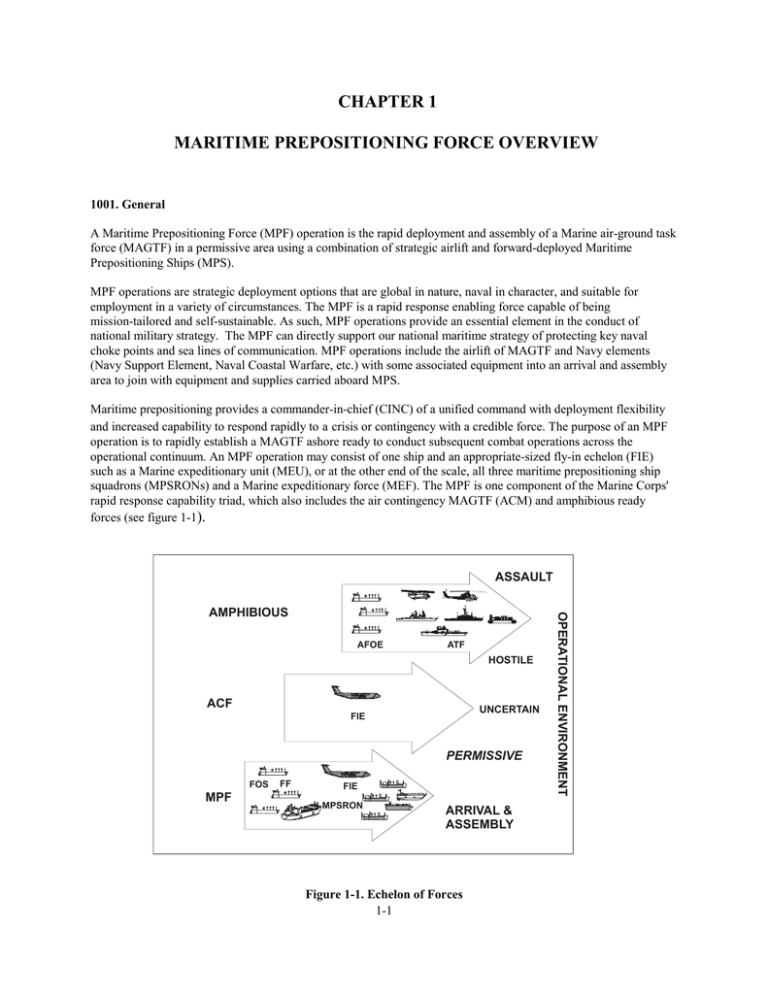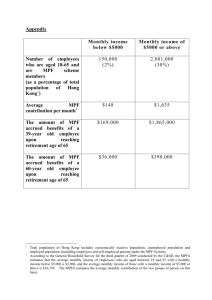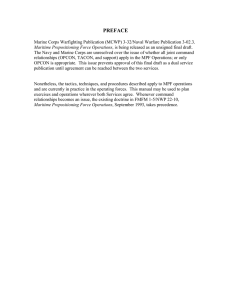CHAPTER 1 MARITIME PREPOSITIONING FORCE OVERVIEW
advertisement

CHAPTER 1 MARITIME PREPOSITIONING FORCE OVERVIEW 1001. General A Maritime Prepositioning Force (MPF) operation is the rapid deployment and assembly of a Marine air-ground task force (MAGTF) in a permissive area using a combination of strategic airlift and forward-deployed Maritime Prepositioning Ships (MPS). MPF operations are strategic deployment options that are global in nature, naval in character, and suitable for employment in a variety of circumstances. The MPF is a rapid response enabling force capable of being mission-tailored and self-sustainable. As such, MPF operations provide an essential element in the conduct of national military strategy. The MPF can directly support our national maritime strategy of protecting key naval choke points and sea lines of communication. MPF operations include the airlift of MAGTF and Navy elements (Navy Support Element, Naval Coastal Warfare, etc.) with some associated equipment into an arrival and assembly area to join with equipment and supplies carried aboard MPS. Maritime prepositioning provides a commander-in-chief (CINC) of a unified command with deployment flexibility and increased capability to respond rapidly to a crisis or contingency with a credible force. The purpose of an MPF operation is to rapidly establish a MAGTF ashore ready to conduct subsequent combat operations across the operational continuum. An MPF operation may consist of one ship and an appropriate-sized fly-in echelon (FIE) such as a Marine expeditionary unit (MEU), or at the other end of the scale, all three maritime prepositioning ship squadrons (MPSRONs) and a Marine expeditionary force (MEF). The MPF is one component of the Marine Corps' rapid response capability triad, which also includes the air contingency MAGTF (ACM) and amphibious ready forces (see figure 1-1). ASSAULT AFOE ATF HOSTILE ACF UNCERTAIN FIE PERMISSIVE FOS MPF FF FIE MPSRON ARRIVAL & ASSEMBLY Figure 1-1. Echelon of Forces 1-1 OPERATIONAL ENVIRONMENT AMPHIBIOUS Each component of the triad can be used separately or can be integrated together to further enhance a CINC's available options. MPF operations are economy of force measures that allow deployment of an appropriate force if a crisis arises. The MPF offers an augmentation capability for amphibious operations, but is not a substitute for amphibious operations due to an inherent lack of forcible entry capability. Other advantages of MPF operations include a means to deploy forces without impact on previously deployed forces, and a method to rapidly augment a forward-deployed MAGTF, ongoing amphibious deployment or operation, or other joint/multinational force operations. 1002. Strategy The development of the naval force structure derives from the National Military Strategy, two tenets of which are forward presence and crisis response. The capability to reinforce U.S. forward-deployed forces and multinational partners, and to project combat power across the spectrum of conflict are essential ingredients of the National Military Strategy. a. Forward Presence MPSRONs are strategically based around the globe (see figure 1-2), and naval forces are capable of linking-up with them in an operational area in a matter of days. This capability, given credence by frequent exercises (often in concert with multinational partners), demonstrates commitment, reinforces alliances, enhances regional stability, promotes U.S. influence and access, and is especially responsive to regional crises or natural disasters. MPSRON 3 MPSRON 1 MPSRON 2 Figure 1-2. MPSRON Locations b. Crisis Response The MPF, one component of Marine Corps Operating Forces, is designed to respond independently, or in conjunction with other forces, to a variety of regional crises. The threat faced today is uncertain. A regional crisis can arise in any geographical location and can arise (as history demonstrates) on short notice. Quick and credible response is required to deter an escalation in hostilities; if deterrence fails, the ability to fight and win decisively is crucial. The MPF provides this capability. 1-2 1003. Naval Character Maritime prepositioning provides a CINC with flexibility, and increases the national capability to respond rapidly to crises. The forward positioning of MPS and the capability to deploy associated naval forces by strategic airlift are integral elements of a global naval presence. 1004. Capabilities The essential contribution of MPF operations to national strategic capabilities is the mobility and flexibility which allows for a concentration of forces quickly in a specified area (see figure 1-3). The existence of this power projection capability is a deterrent to potential adversaries. MPF and amphibious operations are complementary capabilities; one is not an equivalent substitute for the other. Amphibious operations provide the means for forcible entry, while MPF permits rapid deployment into permissive areas where force introduction is essentially unopposed and is expected to remain so through the arrival and assembly phase. Amphibious operations can be used in the same environment as MPF, but the inverse is not true. The MPF possesses heavier forces with greater sustainment than that typically available to amphibious forces. MPF enables employment of a MAGTF in a variety of roles, including— Augmenting an amphibious deployment or operation Occupying or augmenting an advanced naval base Preemptively occupying and defending key choke points along Sea Lines Of Communication (SLOC) Establishing a blocking position for both offensive and defensive operations Reinforcing multinational partners with a credible force prior to hostilities, and sustaining relations with routine exercises and operations Establishing a sizable force ashore to enable closure of additional forces and to support the theater commander's campaign Deterring adventurism through diplomatic signaling afforded by positioning MPS and alerting Marine and Navy forces Providing a rapid peacetime response in support of humanitarian assistance and disaster relief Providing economy of force through reduction of strategic airlift requirements, and reduction or elimination of the need to employ amphibious forces capable of forcible entry to a contingency that does not require such force Augmenting fleet defense by providing tactical air support from ashore 1-3 SEA LINES OF COMMUNICATION STRATEGIC CHOKE POINTS Figure 1-3. Maritime Strategy 1005. Considerations for Employment The essential requirement for an MPF operation is a permissive environment that allows for arrival and off-load of ships and aircraft, and the joining of personnel and materials for force standup. Regardless of the mission assigned for subsequent operations, the following conditions are required to establish the MPF MAGTF ashore: A permissive environment from initiation of strategic deployment through completion of arrival and assembly Adequate strategic airlift and aerial tanker support Adequate off-load forces (i.e., MAGTF and NSE) to support the operation Sufficient airfield space for Marine Corps tactical aircraft, Air Mobility Command (AMC), and Civil Reserve Air Fleet (CRAF) operations, and throughput capability to support the intended airflow An ample port and/or beach area for timely off-load and throughput. The port must have sufficient water depth, adequate overhead clearance, and maneuver room to admit MPS. Beaches and approaches must be evaluated for hydrographic supportability as well as being swept for mines and other hazards A suitable transportation network between the port and/or beach, airfields, and assembly areas to permit a timely arrival and marrying-up of airlifted units with sealifted equipment and supplies. This may include railroads, barge traffic, and pipelines Adequate force protection capabilities to meet any potential threat to forces in the arrival and assembly area 1-4 1006. Essential Features of MPF a. National Military Strategy MPF is a key asset in the National Military Strategy (NMS) by providing regional focus, an adaptive planning capability (i.e., tailoring forces for a particular circumstance), and force presence options. Through regional focus, each MPSRON, and the forces from the associated MEF, can respond worldwide, but remain especially responsive to the theaters that are designated as major theater war (MTW) and smaller scale contingencies (SSC) and supported by operation plans (OPLANs) or contingency plans (CONPLANs). The adaptive planning process reflects the fundamental change to our post-Cold War military strategy. It encompasses all the instruments of our national power: diplomatic, political, economic, and military. The purpose of this adaptive planning process is to provide decisionmakers with a range of preplanned options in order to clearly demonstrate U.S. resolve, deter potential adversaries, and (if necessary) deploy and employ forces to fight and win, quickly and decisively. For the military component of these options, MPF provides a CINC with a wide range of capabilities to size the force for a particular mission. Force presence options exist because the MPSRONs are forward-deployed continually, and serve as an ever-present reminder of U. S. capability and resolve. When teamed with amphibious or other forward-deployed naval forces, MPS can enhance a force presence with potent complementary capabilities easily recognized by a potential adversary. b. Rapid Response The goal of MPF is to establish a MAGTF ashore as rapidly as possible, and for the MAGTF to be fully operational within 10 days or less following initiation of the off-load. Achieving this rapid response requires positioning MPS in areas of concern so that the chief constraint on force deployment is airlift, not sealift, closure. To maintain the rapid response capability, joint force commanders with directive authority for logistics should not transfer maritime prepositioned equipment and supplies (MPE/S) to other services unilaterally. The MPE/S may be transferred to other services; however, the supported CINC should obtain concurrence from the Commandant of the Marine Corps (CMC) and the Chief of Naval Operations (CNO). c. Global Capability In view of our global responsibilities, MPF can provide the flexibility for simultaneous or sequential employment of forces worldwide. To achieve this flexibility, various-sized MAGTFs can be deployed to marry-up with MPE/S. Inherent within the MPF structure is the capability for single- or multi-theater operations. d. Flexible Command Relationships Command relationships for the MPF operation will be promulgated by the establishing authority. Command relationships should be as consistent as possible throughout the MPF operation to ensure command continuity and reduce potential confusion; however, the relationships must provide the flexibility to respond to new requirements. e. Sustainment of Maritime Prepositioning Forces Sustainment of MPFs is the combination of prepositioned and airlifted materiel. An MPF MAGTF of approximately 18,000 Marines and sailors utilizing a full MPSRON will be capable of a 30-day sustainment. Smaller MAGTFs may be sustained ashore for greater or lesser amounts of time depending on the size of the force, the number of MPS in support of that force, and variables such as— Inclusion of an aviation logistics support ship (TAVB) Follow-on sustainment shipping 1-5 The length of sea lines of communication Host nation support 1007. Concept of MPF Operations An MPF operation can evolve from a small force (MEU) to a large force (MEF). Planning is continuous throughout the operation. In execution, the operation extends from marshalling through arrival and assembly of the MAGTF and regeneration of the MPF. It involves the elements that comprise the MPF and supporting forces such as the Commander in Chief, United States Transportation Command (USCINCTRANS) with local transportation and deployment support agencies, host nation and supported/supporting CINC assets, and any other support the situation may demand. The geographic scope of the operation will vary, but it is inherently a strategic or intertheater capability. While MPF operations are conceptually simple, the strategic dimensions of the operation, the number of major commands involved as the force transits from theater to theater (and CINC to CINC), and the intricacies of the Joint Operation Planning and Execution System (JOPES) make the operation extremely complex. The overlap of phases and geographic separations places heavy demands on command elements. The magnitude of an operation may require activation of Navy reserves to conduct the off-load, and Marine Corps reserves to conduct civil affairs and MAGTF operations. It is critical that MPF operations be based on comprehensive, deliberate planning. Development of general purpose contingency plans must establish clear relationships, identify specific areas of responsibility, and provide for effective, efficient communication channels. Deliberate plans will speed mission analysis and the estimate process during crises. Conflicting demands of deployment and employment considerations will dictate a dynamic planning process that must remain responsive to the current situation. Operational planning must begin with a risk/threat assessment to determine whether MPF operations are the appropriate force deployment option. Two other facets of an MPF operation increase its complexity. First, some planning factors will be determined late in the decisionmaking process because of the remoteness of the deployment area and uncertainty of the situation. Second, subsequent operations will have a significant impact on execution planning. Accordingly, commanders must visualize their concept of operations ashore to determine their arrival and assembly plans, which determine their deployment plans. 1008. The MPF's Focus on the MAGTF An MPF operation begins with the decision to employ an MPF MAGTF and the issuance of the necessary directives to the major participants (e.g., the supporting and supported CINCs and USCINCTRANS). After receipt of an alert/warning order, an initiating directive should be issued by the establishing authority to subordinate commanders. Planning for MPF operations is continuous, but the execution planning phase begins with the assignment of a specific mission. Termination of the arrival and assembly phase of an MPF operation occurs when all prerequisites in the initiating directive are met and the MAGTF is established ashore. The MAGTF is established ashore when— Adequate equipment and supplies are off-loaded and issued to arriving units Command and control capabilities of the MAGTF are established The MAGTF commander is ready to execute the assigned employment mission The MAGTF commander will report mission readiness to the establishing authority (the commander who published the MPF initiating directive), who will then terminate the arrival and assembly phase. Subsequent MAGTF operations ashore are separate from the MPF operation. After completion of the MAGTF operational mission, the MPF operation resumes with the regeneration of the MPSRON. 1-6 1009. Types of MPF Operations Independent MPF operations are those in which the MAGTF Commander has dual responsibilities as the Marine Corps forces (MARFOR) (service component) commander to a subordinate unified command, joint task force, or multinational force (e.g., NATO). The key discriminator is that the MPF MAGTF remains an independent entity that is not subsumed into another MARFOR. Augmentation MPF operations are those in which the MAGTF Commander's immediate superior is a MEF, service component, functional component, or task force (e.g., naval, amphibious, etc.) commander. 1010. Phases of an MPF Operation The five phases in an MPF operation are discussed below. Command relationships for each phase are discussed in chapter 3. a. Planning The planning phase begins upon receipt of the warning order. As in any other military operation, planning is continuous throughout an MPF operation. MPF operations are characterized by two planning methodologies: deliberate planning and crisis action planning (CAP). Deliberate planning is conducted principally in peacetime, preparing for future, hypothetical military operations. CAP is conducted in response to present situations that might require a U.S. military response. MPF operational planning is discussed in detail in chapter 4. b. Marshalling During the marshalling phase, units organize and complete final preparations for deployment, including the preparation of personnel and equipment, movement to an aerial port of embarkation (APOE), staging, and loading aboard aircraft. The marshalling phase begins on arrival of the first element at a designated marshalling point and ends on departure of the last element from a departure airfield. Marshalling is discussed in chapter 9. c. Movement The movement phase consists of the movement of forces by air and sea to the arrival and assembly area (AAA). The movement phase begins on lift-off of the first aircraft from the departure airfield or when the first MPS begin transit to the designated AAA. This phase ends when the last FIE aircraft arrives in the AAA and the last ship arrives at the off-load point. Movement is discussed in chapter 9. d. Arrival and Assembly The arrival and assembly phase begins on arrival of the first MPS or the first aircraft of the main body at the designated AAA. This phase ends when; adequate equipment and supplies are off-loaded and issued to awaiting units, command and control is established, and the MAGTF commander reports that all essential elements of the MAGTF have attained combat readiness. Simultaneous or subsequent tactical operations by the MAGTF and movements to those operations are not considered part of the MPF operation. The arrival and assembly phase includes (in no specific order)— Initial preparation of an AAA Reception of MAGTF, Navy, and Coast Guard personnel and equipment at nearby airfields Coordinated arrival and off-load of equipment and supplies from the MPS The issue of MPE/S to arriving units A provision of local force protection for arrival and assembly 1-7 The establishment of the MAGTF's combat capability (force standup) Preparation for the MAGTF mission (e.g., movement of the MAGTF to the tactical assembly area (TAA) or the line of departure (LOD)) NOTE: The arrival and assembly phase is discussed further in chapter 10. e. Regeneration During the regeneration phase, the MPSRON is methodically restored to its original strength or properties and full operational capability. Regeneration is conducted as rapidly as possible following the termination of the MAGTF's operational mission. Regeneration is discussed in chapter 11. 1011. Force Protection Security of the MPS, strategic airlift resources, tactical aircraft, and areas within and surrounding the AAA must be considered throughout MPF operations. Force protection impacts on employment considerations, concept of operations, planning, movement of forces, and all activities in the AAA. A thorough discussion of the related force protection responsibilities and key considerations are provided in chapter 5. 1-8




